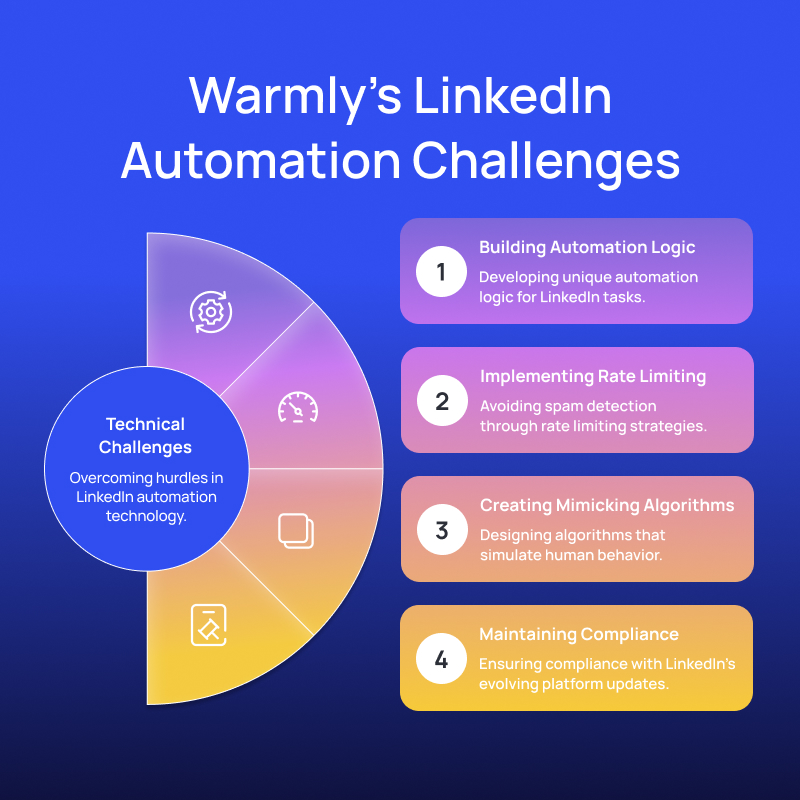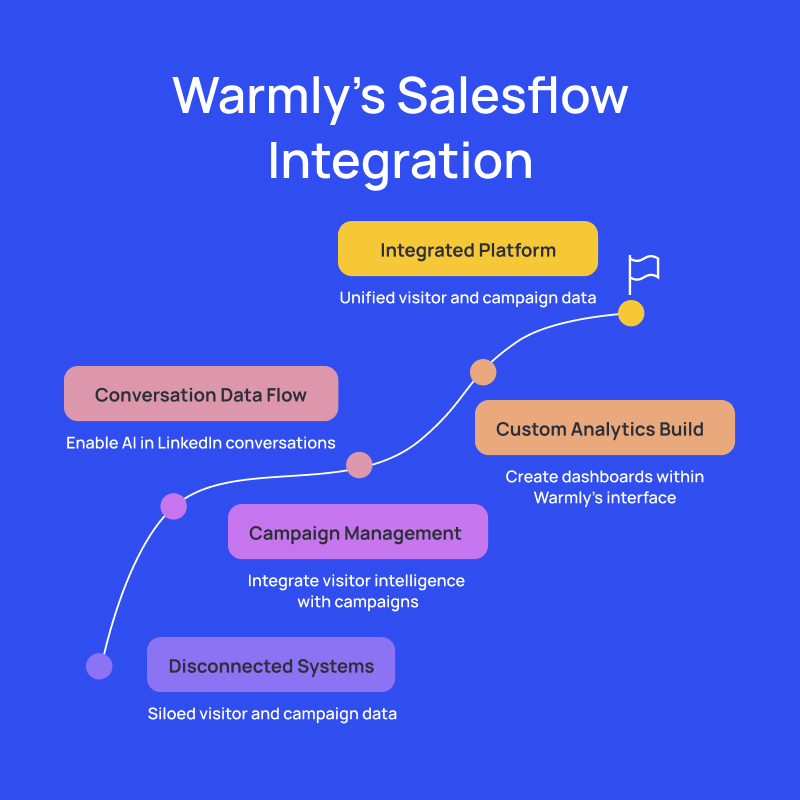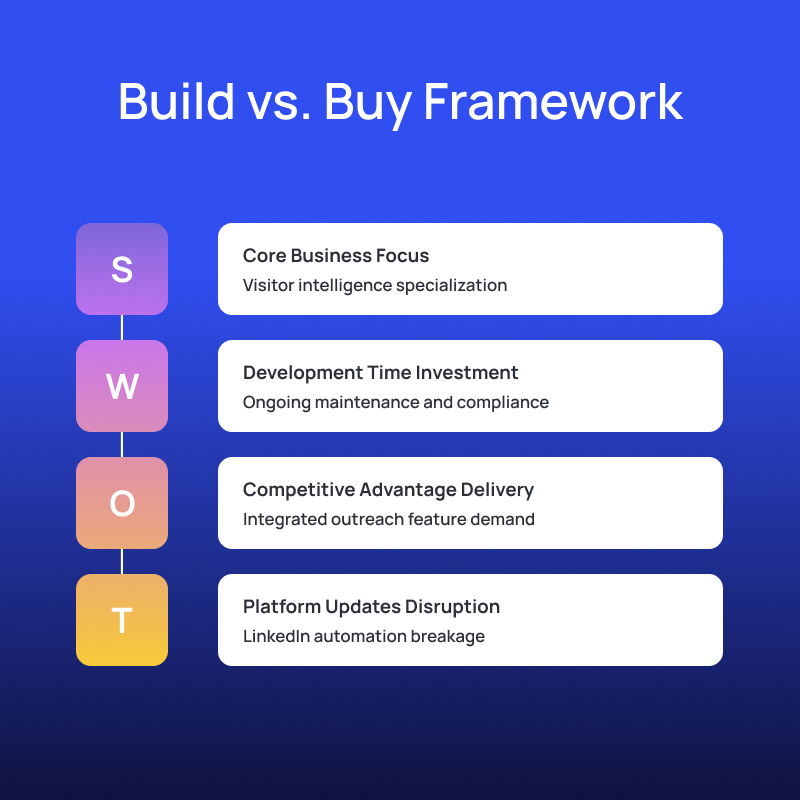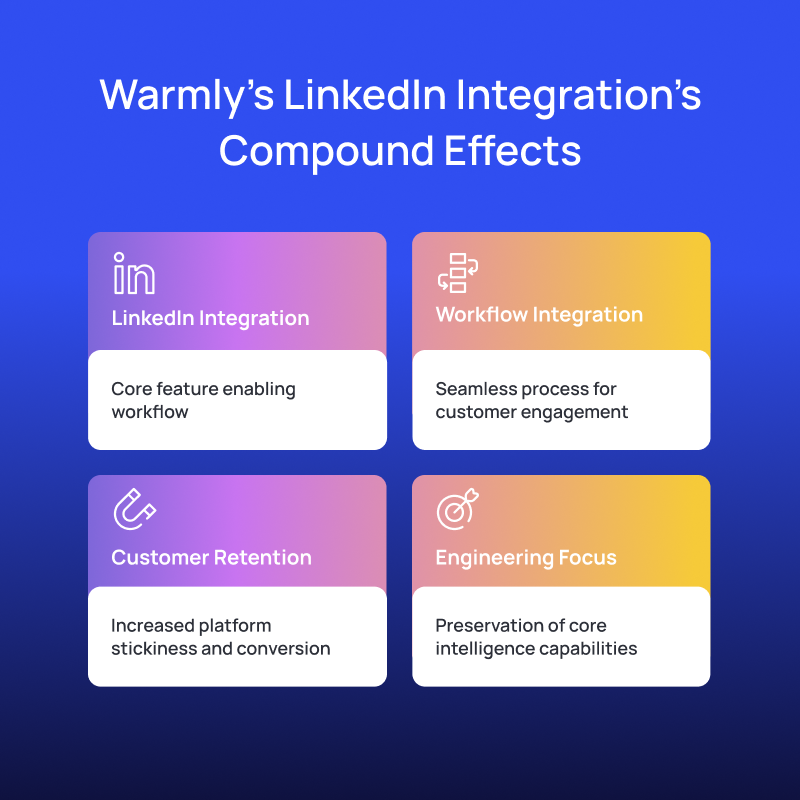Table of Content

Because sometimes the smartest engineering decision is knowing what NOT to build.
Warmly had built something special: a website visitor intelligence platform that could identify anonymous traffic, enrich visitor profiles, and surface buying signals in real-time.
Their customers loved seeing exactly who was browsing their site and when they showed buying intent.
But there was a gap.
Customer after customer would get excited about the intelligence Warmly provided, then ask the inevitable follow-up question: "This is amazing data, now how do I actually reach out to these prospects on LinkedIn?"
The answer was frustrating: manual copy-paste into LinkedIn, generic connection requests, and hope for the best.
For a platform designed to streamline lead intelligence, the outreach process felt disconnected.
The feature requests kept coming, and eventually, LinkedIn outreach integration had become the most-requested addition to Warmly's roadmap.
When Warmly's team started researching what it would take to build LinkedIn automation internally, the scope was daunting.
Unlike most social platforms, LinkedIn doesn't offer a public API for automation. Any outreach solution would require reverse-engineering LinkedIn's entire interaction system: connection requests, messaging, follow-ups, the works.
The technical challenges were significant:

The team's estimate was 6-9 months of development time, plus ongoing maintenance that could consume a significant portion of their engineering resources indefinitely.
"We'd essentially be building a completely different product," one team member noted.
The question became: Should a visitor intelligence company become a LinkedIn automation company?
While researching potential solutions, Warmly discovered Salesflow PaaS: a Platform-as-a-Service specifically designed for enterprise LinkedIn automation integrations.
Instead of consumer-focused automation tools, Salesflow had built a robust API infrastructure that handled all the complex LinkedIn logic behind clean REST endpoints. They'd already solved the hardest problems: the proprietary automation algorithms, compliance requirements, and rate limiting.
The value proposition was compelling. Warmly could integrate LinkedIn outreach without building any of the underlying automation infrastructure.
The timeline comparison was stark:
Warmly's engineering team decided to move forward with the Salesflow integration, focusing on three core API endpoints:
The first integration connected Warmly's visitor intelligence directly to Salesflow's campaign creation system. When Warmly identified a high-intent visitor, that prospect could automatically be imported into a personalized LinkedIn outreach campaign.
Two endpoints handled the messaging flow:
Using the data flowing back from Salesflow's APIs, Warmly built proprietary analytics dashboards within their existing interface. Customers could see conversation rates, response metrics, and campaign performance without leaving Warmly's platform.
The development reality exceeded expectations:

The LinkedIn integration didn't just add a requested feature; it transformed how customers used Warmly's entire platform.
The integration created a new revenue stream through LinkedIn seat upsells. Warmly includes one free LinkedIn seat in their pricing plans to encourage trial adoption. Users who see success quickly expand to multiple paid seats.
This approach drives both customer acquisition and expansion revenue while increasing platform stickiness. Customers could now manage their entire lead generation workflow within a single system.
Perhaps most importantly, Warmly's engineering team avoided the 6+ months of development time that would have been required for an internal build. Those resources remained focused on advancing Warmly's core visitor intelligence capabilities.
Meanwhile, all LinkedIn platform updates, compliance changes, and infrastructure maintenance are handled entirely by Salesflow, eliminating the ongoing operational burden.
Warmly's decision process created a framework that other technical teams can apply:
Warmly's strength is visitor intelligence, not LinkedIn automation. Building outreach infrastructure would have meant becoming a different type of company and sacrificing their current capabilities, with a huge opportunity cost.
Beyond the initial 6-9 month development timeline, an internal build would have required ongoing maintenance, compliance monitoring, and infrastructure scaling, potentially consuming 20-30% of engineering capacity long-term.
Customer requests were accelerating, and competitors were beginning to offer integrated outreach features. Speed of delivery became a competitive advantage.
LinkedIn regularly updates its platform in ways that break automation tools. Salesflow's specialization means we can handle these changes transparently, eliminating a major operational risk.
Salesflow's per-seat pricing aligned perfectly with Warmly's ability to generate expansion revenue through LinkedIn outreach upsells.

For teams evaluating similar integrations, here's what made Warmly's implementation successful:
Salesflow's RESTful endpoints allowed Warmly to build custom UI experiences while leveraging proven backend infrastructure. This meant they could maintain their brand experience while accessing enterprise-grade automation capabilities.
Rather than treating LinkedIn outreach as a separate feature, Warmly integrated conversation data, analytics, and campaign management directly into their existing dashboards. This created a seamless user experience that felt native to their platform.
With a 1,000-seat capacity and proven enterprise reliability, the integration could grow with Warmly's customer base without requiring infrastructure planning or scaling decisions.
Six months after launch, the LinkedIn integration had become more than just a feature addition; it transformed Warmly's entire value proposition.
Customers could now:
The seamless integration between visitor intelligence and outreach capabilities significantly increased platform stickiness.
Customers who had been casual users became power users. Trial-to-paid conversion rates improved as prospects could see the complete workflow value immediately.
While competitors spent months building basic automation features, Warmly's engineering team continued advancing its core visitor intelligence capabilities. This maintained their competitive differentiation while satisfying customer demands for integrated outreach.

Warmly's story illustrates a fundamental truth about modern product development: the most successful companies don't try to build everything themselves.
They identify their unique value proposition and find strategic partners who can accelerate everything else.
By choosing integration over internal development, Warmly:
The integration didn't just add LinkedIn outreach; it completed Warmly's vision of seamless lead intelligence and engagement.
Sometimes the most transformative technical decisions aren't about what you build, but about what you choose not to build.
Warmly's partnership with Salesflow PaaS proves that strategic API integrations can deliver better customer outcomes than internal development, especially for non-core functionality that requires specialized expertise.
The key is recognizing when your engineering resources are better invested in advancing your unique capabilities rather than rebuilding infrastructure that already exists.
Ready to evaluate API integrations for your product roadmap?
Discover how Salesflow PaaS streamlines LinkedIn outreach integration, eliminating development overhead.
Schedule a technical walkthrough to explore what's possible when you focus on your core competencies while leveraging proven infrastructure for everything else.
Because your customers care about seamless experiences, not your technical architecture decisions.